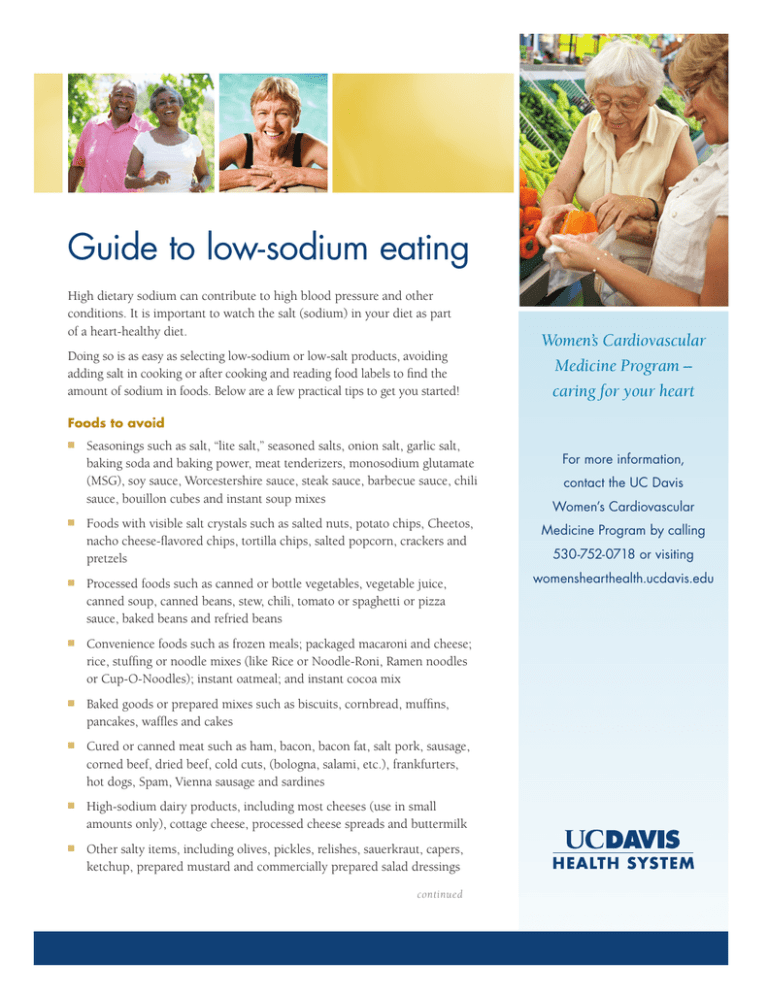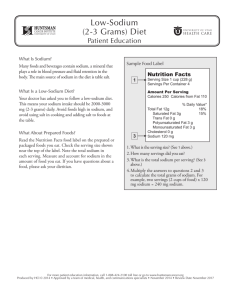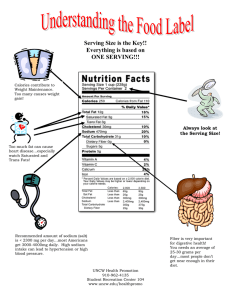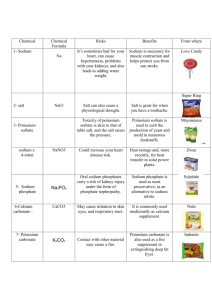Guide to low-sodium eating
advertisement

Guide to low-sodium eating High dietary sodium can contribute to high blood pressure and other conditions. It is important to watch the salt (sodium) in your diet as part of a heart-healthy diet. Doing so is as easy as selecting low-sodium or low-salt products, avoiding adding salt in cooking or after cooking and reading food labels to find the amount of sodium in foods. Below are a few practical tips to get you started! Women’s Cardiovascular Medicine Program – caring for your heart Foods to avoid n n Seasonings such as salt, “lite salt,” seasoned salts, onion salt, garlic salt, baking soda and baking power, meat tenderizers, monosodium glutamate (MSG), soy sauce, Worcestershire sauce, steak sauce, barbecue sauce, chili sauce, bouillon cubes and instant soup mixes Foods with visible salt crystals such as salted nuts, potato chips, Cheetos, nacho cheese-flavored chips, tortilla chips, salted popcorn, crackers and pretzels n Processed foods such as canned or bottle vegetables, vegetable juice, canned soup, canned beans, stew, chili, tomato or spaghetti or pizza sauce, baked beans and refried beans n Convenience foods such as frozen meals; packaged macaroni and cheese; rice, stuffing or noodle mixes (like Rice or Noodle-Roni, Ramen noodles or Cup-O-Noodles); instant oatmeal; and instant cocoa mix n Baked goods or prepared mixes such as biscuits, cornbread, muffins, pancakes, waffles and cakes n Cured or canned meat such as ham, bacon, bacon fat, salt pork, sausage, corned beef, dried beef, cold cuts, (bologna, salami, etc.), frankfurters, hot dogs, Spam, Vienna sausage and sardines n High-sodium dairy products, including most cheeses (use in small amounts only), cottage cheese, processed cheese spreads and buttermilk n Other salty items, including olives, pickles, relishes, sauerkraut, capers, ketchup, prepared mustard and commercially prepared salad dressings continued For more information, contact the UC Davis Women’s Cardiovascular Medicine Program by calling 530-752-0718 or visiting womenshearthealth.ucdavis.edu The sodium antidote Recent research has shown that potassium helps neutralize sodium’s effect on blood pressure. It also seems to lower the risk of stroke apart from its effect on blood pressure. Unfortunately, many of us don’t get enough potassium in our diets. The solution: Eat more fruits and vegetables high in potassium. n Examples of vegetables high in potassium: potatoes, spinach, raisins, lima beans and lentils n Examples of fruits high in potassium: bananas, oranges, watermelon and cantaloupe An additional solution is to use fresh herbs (cilantro, basil, oregano, cumin, garlic, onion, rosemary, etc.) to give food flavor. Note: check with your doctor as some persons should not eat a high-potassium diet. Nutrition Facts Serving Size 1 cup (253g) Servings Per Container 2 Amount Per Serving Calories 260 Calories from Fat 72 Total Fat 8g Saturated Fat 3g Cholesterol 120mg Sodium 1010mg Total Carbohydrate 22g Dietary Fiber 9g Sugars 4g Protein 25g Finding sodium content on food labels In addition to limiting the foods listed, you should learn to check food labels for sodium. When reading labels for sodium always check the serving size, and avoid or limit foods with more than 500 mg per serving. Your total amount of sodium per day should be no more than 1,500-2,000 mg (one gram of sodium is the same as 1,000 milligrams). Your physician may give you a specific guideline regarding your sodium allowance. Examples of low-sodium levels: 5 mg = sodium-free food 35 mg = very low-sodium food 140 mg = low-sodium food (per serving) A prepackaged meal should contain no more than 500 mg of sodium. 500 mg = low-sodium meal n Check the serving size – if needed, use a measuring cup to measure the serving size 25% = reduced-sodium product n Check the milligrams (mg) of sodium – keep your daily maximum in mind when looking at sodium on a label What else works for lowering blood pressure? If your blood pressure is high, the chart below shows how lifestyle changes can lower it! Details Drop in systolic blood pressure Weight loss For every 20 pounds you lose 5 to 20 points Follow the DASH diet Eat a lower-fat diet rich in vegetables, fruits and lowfat dairy foods 8 to 14 points Advice Exercise daily Get 30 minutes a day of aerobic activity 4 to 9 points Limit sodium Eat no more than 1,500-2,000 mg a day 2 to 9 points Limit alcohol Have no more than two drinks a day for men and one drink a day for women (one drink = 12 oz. beer, 5 oz. wine or 1.5 oz. 80-proof whiskey) 2 to 4 points




